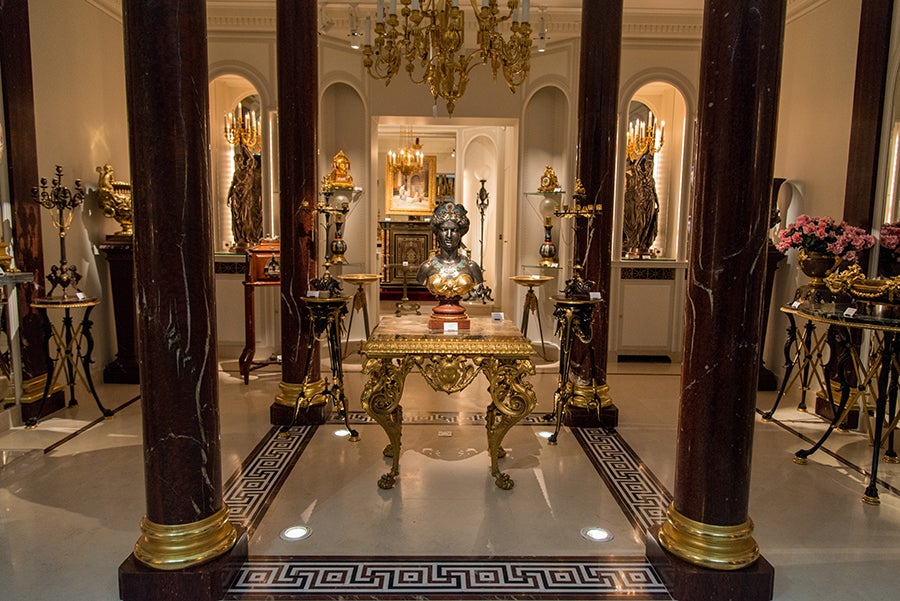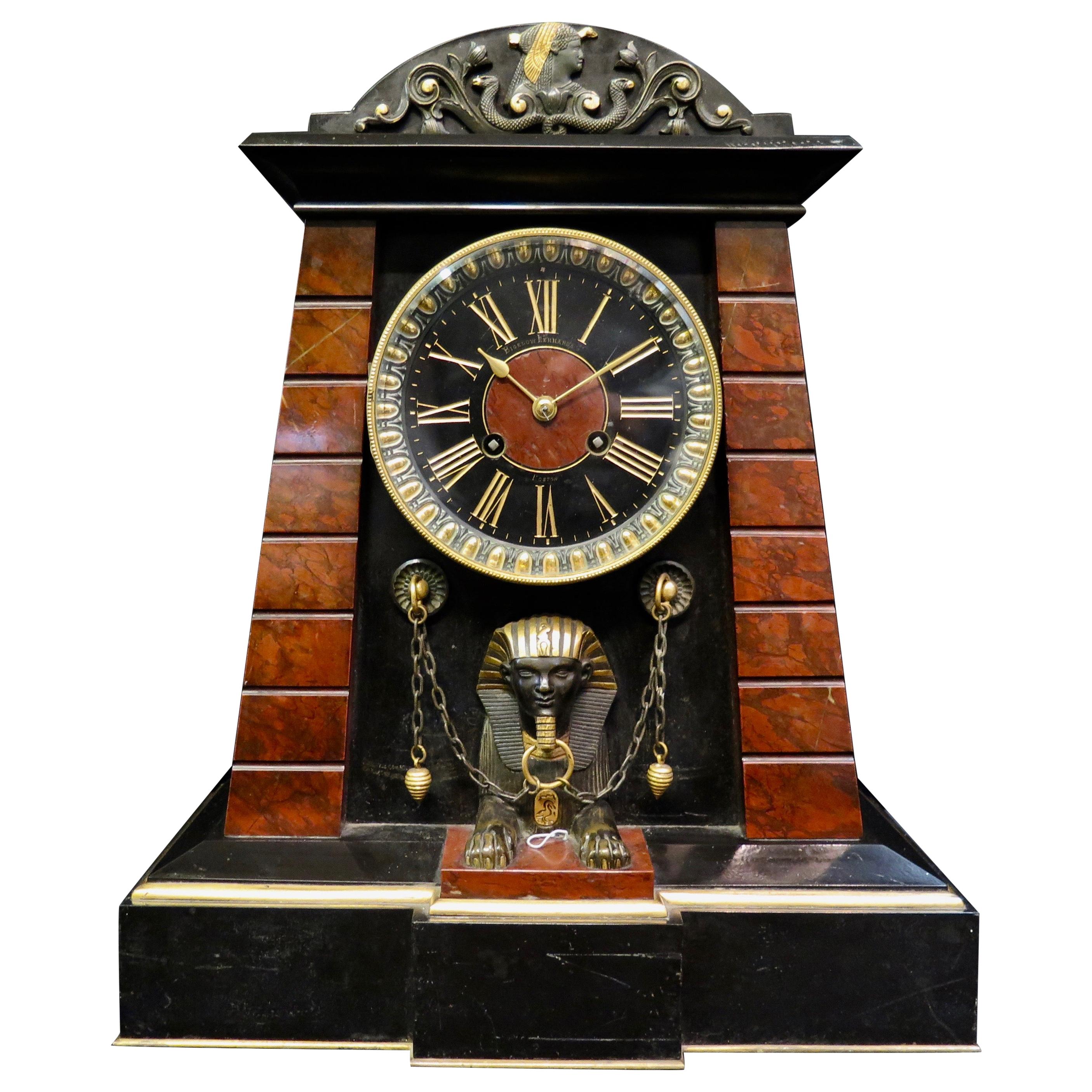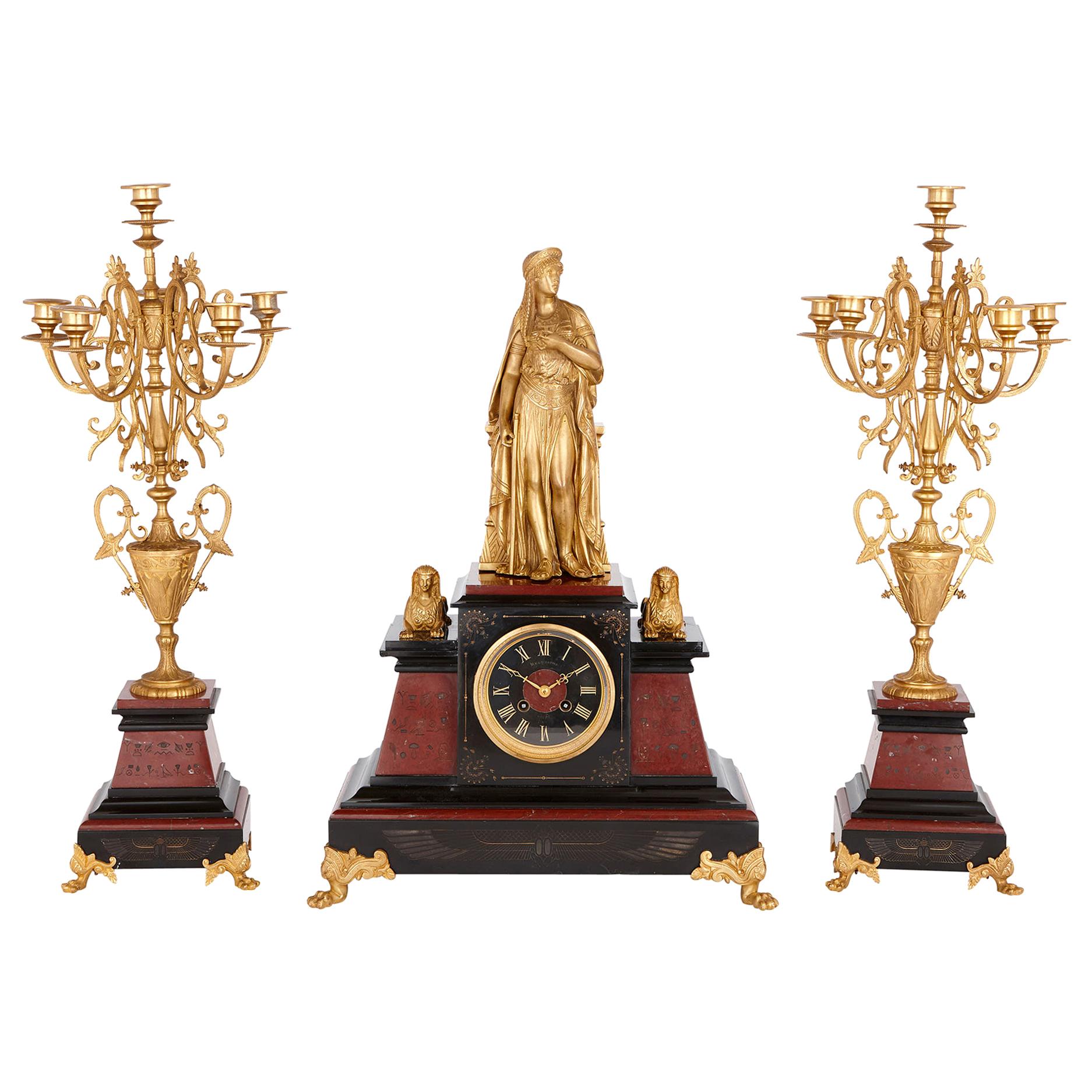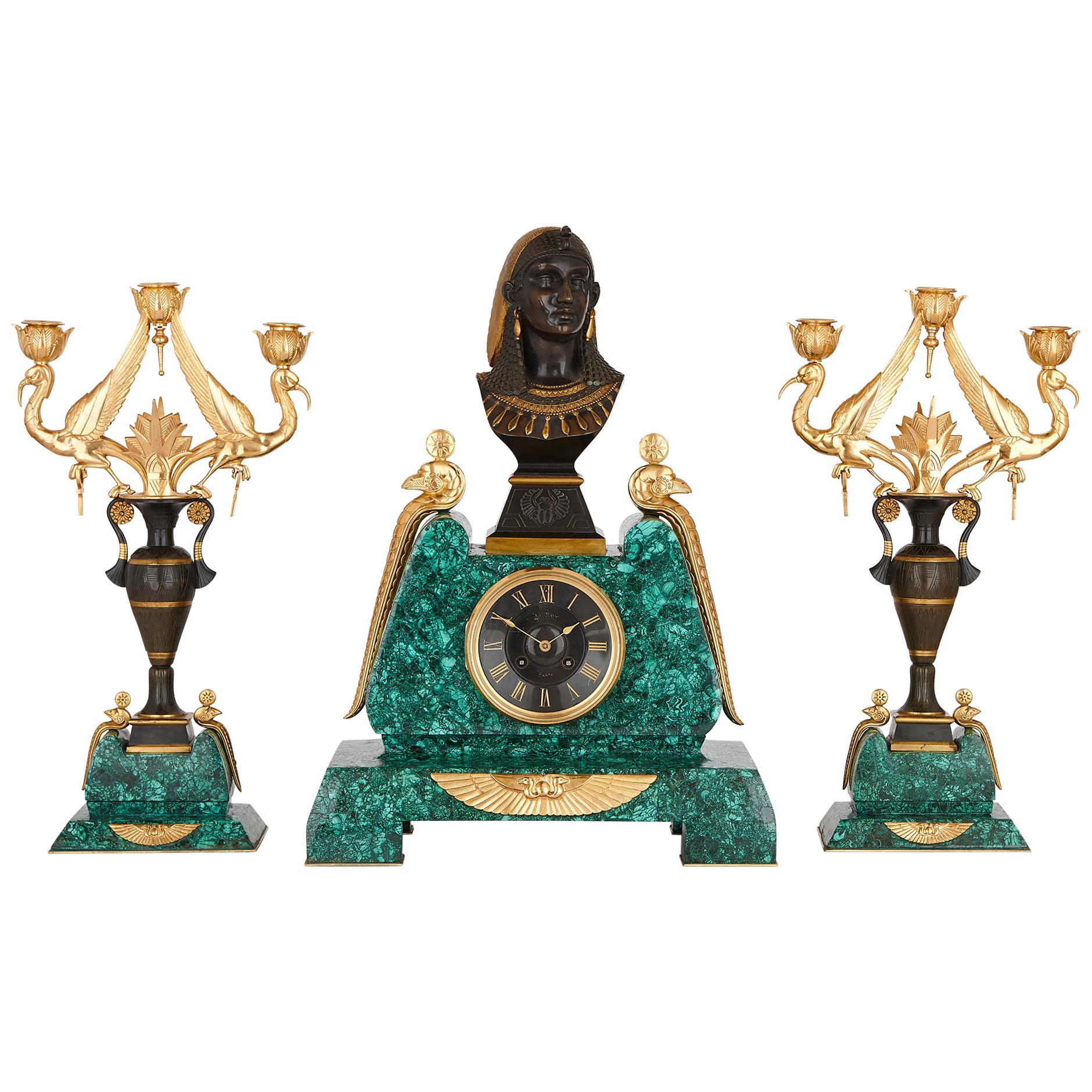Items Similar to Neo-Egyptian Bronze and Marble Clock Attributed to G.Servant, France, Circa 1870
Want more images or videos?
Request additional images or videos from the seller
1 of 9
Neo-Egyptian Bronze and Marble Clock Attributed to G.Servant, France, Circa 1870
About the Item
A black and red marble clock in the shape of an Egyptian temple attributed to G. Servant, flanked by double columns inscribed with hieroglyphs and ornated with a winged uraeus, all made in two patina bronze. The clock is surmounted by a patinated bronze sphinx. Resting on four bronze faces wearing the nemes and terminating in lion paw feet.
Georges Emile Henri Servant (circa 1828-1890) who took over his father in 1855 at their foundry, rue Vieille-du-Temple, in Paris, specialized in the production of neo-Egyptian style clocks, very popular in France since 1860s, and also the making of Greek style decorative objects. He drew considerable attention to the high quality of his bronzes at the 1855 Paris Universal Exhibition and then at the 1862 London Exhibition. At this time Servant exported up to 40% of his production, principally to the United States, where for instance, his sphinx clocks were sold with great success by Louis Tiffany Inc. or Hamann & Roche of New York (A similar clock is now exposed at the Metropolitan Museum of Art, New York). But his success came really at the 1867 Paris Universal Exhibition, where he was awarded a gold medal for his neo-Greek and Egyptian works (Les Merveilles de l’Exposition Universelle de 1867, t. II, p° 165 & 167). He was even awarded in 1874 the « Ordre national de la Légion d’Honneur », France’s hightest official mark of recognition. Servant participated once again successfully at the 1878 Paris Universal Exhibition, where he not only exhibited vases and small bronze pieces of furniture, but was also a member of the jury for the class of bronze pieces of art. He finally retired shortly before the 1889 Paris Universal Exhibition.
- Attributed to:Georges Emile Henri Servant (Maker)
- Dimensions:Height: 18.12 in (46 cm)Width: 15.36 in (39 cm)Depth: 6.7 in (17 cm)
- Style:Egyptian Revival (In the Style Of)
- Materials and Techniques:
- Place of Origin:
- Period:
- Date of Manufacture:circa 1870
- Condition:Wear consistent with age and use.
- Seller Location:PARIS, FR
- Reference Number:

About the Seller
4.9
Vetted Seller
These experienced sellers undergo a comprehensive evaluation by our team of in-house experts.
Established in 1997
1stDibs seller since 2018
73 sales on 1stDibs
Typical response time: <1 hour
Associations
International Confederation of Art and Antique Dealers' Associations
- ShippingRetrieving quote...Ships From: PARIS, France
- Return PolicyA return for this item may be initiated within 7 days of delivery.
More From This SellerView All
- Pair of Neo-Greek Bronze Candelabras Attributed to G.Servant, France, Circa 1870By Georges Emile Henri ServantLocated in PARIS, FRRare pair of Greek style candelabras made in patinated bronze and gilded bronze, attributed to G. Servant. Each with ten light arms topped by a heron shaped extinguisher. Decorated with various Greek style motifs such palmets, pine cones ans water leaves. Standing on a small triangular architecture presenting a theatre mask and reposing on a tripod base formed with lion paw feet. Georges Emile Henri Servant (circa 1828-1890), who took over his father in 1855 at their foundry, rue Vieille-du-Temple, in Paris, specialized in the production of neo-Egyptian style clocks, very popular in France since 1860’s, and also the making of Greek style decorative objects. He drew considerable attention to the high quality of his bronzes at the 1855 Paris Universal Exhibition and then at the 1862 London Exhibition. At this time Servant exported up to 40% of his production, principally to the United States, where for instance, his clocks were sold with great success by Louis Tiffany Inc. or Hamann & Roche of New York. But his success came really at the 1867 Paris Universal Exhibition, where he was awarded a Gold Medal for his neo-Greek and Egyptian works (Les Merveilles...Category
Antique 1870s French Greek Revival Table Lamps
MaterialsBronze
- Pair of Neo-Greek Pedestals, attributed to G.Servant, France, Circa 1880By Georges Emile Henri ServantLocated in PARIS, FRPair of patinated and gilded bronze turntable pedestals with for each of them, three paw feet, headed by stylized lion muzzles, ornated with beaded chains and joined by a fine foliate stretcher. The belt is adorned by a banded frieze cast in low-relief representing an ancient scene : “The Battle of the Lapithes and the Centaurs”. These pedestals can be associated with the "Vases de Bacchus", presented by G. Servant at the 1867 Exposition Universelle, on which the similar ornamentation is applied. (Reproduced in « Merveilles de l'Exposition Universelle de 1867 », Jules Mesnard, p°167) Biography : Georges Emile Henri Servant...Category
Antique 1880s French Greek Revival Pedestals
MaterialsBronze
- Pair of Neo-Greek Floor Lamps Attributed to G. Servant, France, Circa 1870By Georges Emile Henri ServantLocated in PARIS, FRRare pair of Greek style floor lamps made in patinated bronze attributed to G. Servant, each surmounted of a frosted glass globe engraved of stars and a Greek motif frieze. The body of the vase, decorated with Greek style patterns such as palmets, Greek motif frieze and water leaves, stands on a shaft decorated with deer heads. Fine chains are connected to a delicate butterfly. The set is based on tripod legs with lion claw feet alternating large palmets. Height : 183 cm (72 in.) ; 213 cm (83 3/4 in.) with glass shades ; Diameter : 43 cm (19 2/3in.) Georges Emile Henri Servant (1828-c.1890), who took over his father in 1855 at their foundry, rue Vieille-du-Temple, in Paris, specialized in the production of neo-Egyptian style clocks, very popular in France since 1860’s, and also the making of Greek style decorative objects. He drew considerable attention to the high quality of his bronzes at the 1855 Paris Universal Exhibition and then at the 1862 London Exhibition. At this time Servant exported up to 40% of his production, principally to the United States, where for instance, his clocks were sold with great success by Louis Tiffany Inc. or Hamann & Roche of New York. But his success came really at the 1867 Paris Universal Exhibition, where he was awarded a gold medal for his neo-Greek and Egyptian works (Les Merveilles...Category
Antique 1860s French Greek Revival Floor Lamps
MaterialsBronze
- Neo-Greek Silvered Bronze Bowl Attributed to G. Servant, France, circa 1880By Georges Emile Henri ServantLocated in PARIS, FRBeautiful silvered bronze neo-Greek style bowl in a circular shape, adorned on the body with female masks in the antique style and on the sides with handles in the shape of busts of ...Category
Antique 1880s French Greek Revival Decorative Bowls
MaterialsGriotte Marble, Bronze
- Fine Neo-Greek Clock Set by H. Houdebine, France, Circa 1867By Henri HoudebineLocated in PARIS, FRDial signed H. Houdebine, Fabricant de Bronzes, Rue de Turenne 64, Paris and clockwork signed Japy Frères & Cie – Médaille d’Honneur A very fine neo-Greek style clock set made up of...Category
Antique 1860s French Greek Revival Table Clocks and Desk Clocks
MaterialsBronze
- Important Five Pieces Marble and Gilded Bronze Clock Set, France, Circa 1860By Henri PicardLocated in PARIS, FRMarked on the dial Furet & Bon, Hrs du Roy, à Paris Measures: Clock – Height 98 cm (38 1/2 in.), width 70 cm (27 1/2 in.), depth 25 cm (9 3/4 in.) Candelabra – Height 116 cm (45 ...Category
Antique 1860s French Louis XVI Mantel Clocks
MaterialsMarble, Bronze
You May Also Like
- Egyptian Revival Bronze and Marble French Mantle ClockBy Mermod Jaccard & Co.Located in Bronx, NYThis wonderful 1920s Egyptian Revival clock is surmounted with an Assyrian style lamassau (human headed winged lion) and flanked by a pair of re...Category
Early 20th Century French Egyptian Revival Mantel Clocks
MaterialsBelgian Black Marble
- French Egyptian Revival Patinated Bronze and Marble Mantle ClockBy Bigelow Kennard & Co.Located in Bronx, NYThe clock having domed trapezoidal case, dome with bronze relief to front depicting a partial gilt Egyptian goddess, Isis, flanked by cobras and lotus scrolls, red marble ribbed columns to sides, clock face with gilt egg-and-dart border, gilt hands and mounts, clock face engraved BIGELOW KENNARD & CO. BOSTON, double-barrel clock movement by Achille Brocot, down to chained sphinx protruding from lower case, raised on stepped plinth. This vintage mantle clock...Category
Antique Late 19th Century American Egyptian Revival Mantel Clocks
MaterialsMarble
- Egyptian Style Clock Set in Patinated Bronze and Sienna MarbleLocated in London, GBStylish French clock set in the Retour d'Egypt style based on French Empire clocks from the early 19th century. The clock set upon a good rectangular Sienna marble base on which are ...Category
Antique 1860s French Egyptian Revival Mantel Clocks
MaterialsSiena Marble, Bronze
- Antique Egyptian Revival Style Marble and Gilt Bronze Clock SetLocated in London, GBThis clock set is designed in the Egyptian Revival style, which was in vogue in Europe and America in the 19th century. The fashion was kick-started by Emperor Napoleon I’s campaign in Egypt in 1798-1799. This led to the publication of ‘Le Description de l’Égypte’ (The Description of Egypt) in 1809 (and a second edition in 1830), which documented various aspects of Egyptian culture, including the pyramids, antiquities, ancient and modern buildings, Egyptian clothing...Category
Antique 19th Century French Egyptian Revival Mantel Clocks
MaterialsMarble, Bronze, Ormolu
- Egyptian Revival Malachite, Marble, Gilt and Patinated Bronze Clock SetBy Charles Le RoyLocated in London, GBThis magnificent clock set is signed ‘Le Roy’, most likely for Le Roy et fils. Founded in 1785, Le Roy et fils was an acclaimed French clock-making firm...Category
Early 20th Century French Egyptian Revival Mantel Clocks
MaterialsMarble, Malachite, Bronze
- Egyptian Revival Marble, Gilt and Patinated Bronze Three-Piece Clock SetLocated in London, GBAttributed to Emile Herbert, French, 1828-1893. Comprising a central clock and a pair of flanking lidded vases, the clock on a red and black marble base with Pharaoh busts...Category
Antique 19th Century French Egyptian Revival Mantel Clocks
MaterialsMarble, Bronze





